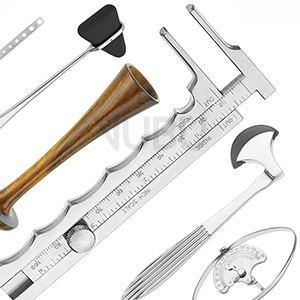Medical diagnostic instruments are essential tools that help doctors and medical professionals identify diseases, assess patients' health conditions, and make informed decisions about their treatment. They form the backbone of every clinical examination and are indispensable across all medical fields—from general practice to specialized disciplines.
In our product range, you will find a wide selection of high-quality diagnostic instruments that meet the highest medical standards. These include:
Reflex Hammers: Used to test neurological reflexes, a crucial part of neurological examinations.
Percussion Hammers: For percussion (tapping) of body regions to assess the condition of organs.
Stethoscopes: Essential for auscultation of the heart, lungs, and other organs.
Blood Pressure Monitors: For precise measurement of blood pressure, a key indicator of cardiovascular health.
Dynamometers: Used to measure muscle strength, particularly in rehabilitation and neurology.
Otoscopes: For examining the ear canal and eardrum.
Head Mirrors: For illuminating and examining body cavities, such as the throat.
All of these instruments can be conveniently purchased online in our shop. We place great emphasis on quality, durability, and user-friendliness to ensure that you always have the best tools at hand for your work.
The development of modern diagnostic instruments would not have been possible without the groundbreaking contributions of several renowned doctors and scientists. Among the most significant figures who have shaped medical diagnostics are:
Dr. Ziegler: Known for his work in neurology and the development of the Ziegler hammer.
Dr. Babinsky: Namesake of the Babinski reflex, an important neurological test.
Dr. Rabiner: A pioneer in the study of neurological diseases.
Dr. Taylor: Developer of the Taylor reflex hammer, still widely used today.
Dr. Troemner: Creator of the Troemner hammer, a standard instrument in neurology.
Dr. Dejerine: Influential in the research of nerve diseases.
Dr. Bite: Contributions to the development of instruments for dentistry.
Dr. Jameson: Innovator in ophthalmology (eye medicine).
Dr. Townley: Developed instruments for ENT (ear, nose, and throat) medicine.
Dr. Moeltgen: A pioneer in microsurgery and instrument development.
Dr. Castroviejo: Known for his work in ophthalmology and the development of specialized instruments.
Dr. Epker: Influential in maxillofacial surgery.
Dr. Aly: Contributions to plastic and reconstructive surgery.
Dr. Weber: Developed the Weber test, an important tool in ENT diagnostics.
Dr. Rirap: Innovator in the development of surgical tools.
We owe the modern instruments used in medical diagnostics today to these pioneers. Their innovative ideas and inventions have revolutionized medicine and helped doctors work more precisely and efficiently.
High-quality diagnostic instruments are not only a mark of professionalism but also a decisive factor in the accuracy and reliability of diagnoses. They enable doctors to detect even subtle signs of disease and take the right measures early on. Investing in top-tier instruments is therefore not just a matter of quality but also of patient safety.
Whether in the practice, hospital, or on the go—medical diagnostic instruments are indispensable companions for every doctor. In our product range, you will find a carefully curated selection of instruments that meet the highest standards. Discover our products today and benefit from the combination of traditional craftsmanship and cutting-edge technology.
Diagnostics in the medical and psychotherapy professions as well as in the health professions or psychology is the exact assignment of findings - diagnostic signs or symptoms - to a concept of illness or symptoms in the sense of a syndrome. The established syndrome, together with the suspected cause and origin of the disease, make the diagnosis. The diagnosis is the classification of phenomena and their interpretation, such as those of “health” or “being sick”. The methods of diagnosis (e.g. anamnesis, physical examination, application of imaging methods such as X-ray / MRI or analysis with laboratory values of blood and other body fluids) are summarized with the term diagnostics. The diagnostic procedure always strives for a diagnosis that can be made if the constellation of the collected anamnestic information and / or findings is specific to a clinical picture. If the findings are not sufficient for this, further medical examinations are usually necessary to confirm the diagnosis. Some diseases are only characterized by non-specific symptoms. In these cases, the number of possible diagnoses is continually restricted until there is a sufficient basis for deciding on a specific exclusion diagnosis or at least a specific therapeutic procedure.
